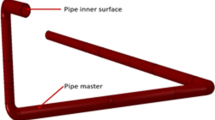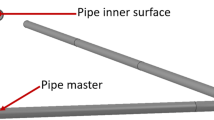Abstract
The paper presents verification results for the validity of a numerical method considering the effect of cold work on Primary water stress corrosion cracking (PWSCC) growth rate in the Alloy 600TT steam generator tubes with a part-through single axial PWSCC. PWSCC growth simulations using Finite element (FE) analysis were performed with considering various cold work levels of the material. From the FE analysis results, the cold work effect was investigated from the variations of the PWSCC growth rate vs. Stress intensity factor (SIF) for the various cold work degrees and initial SIF values. Investigated results were compared with experimental test data available. It was identified that the numerical method could adequately assess the cold work effect on PWSCC growth in the Alloy 600TT tubes. In the simulation, it was found that the cold work could strongly influence the PWSCC growth rate even in a low degree of cold work, less than 2%.
Similar content being viewed by others
References
USNRC, Final report-generic aging lessons learned (GALL), Report. NUREG-1801 (2010).
F. P. Ford and P. L. Andresen, Development and use of a predictive model of crack propagation in 304/316L, A533B/A508, and Inconel 600/182 Alloys in 288°C water, Proceedings of the 3rd Int. Symp. on Environmental Degradation of Mater. in Nucl. Power System-Water Reactors (1988) 789–800.
M. M. Hall and D. M. Symons, Hydrogen assisted creep fracture model for low potential stress corrosion cracking of Ni-Cr-Fe Alloys, Proceedings of Chemistry and Electrochemistry of Corrosion and Stress Corrosion Cracking Symp. (2001) 447–466.
P. M. Scott, An analysis of primary water stress corrosion cracking in PWR steam generators, Proceedings of the NEA/CSNI-UNIPEDE Specialists Meeting on Operating Experience with Steam Generators, OECD NEA, Belgium (1991).
Z. S. Smialowska and R. B. Rebak, Stress corrosion cracking of Alloy 600 in high-temperature aqueous solutions: influencing factors, mechanisms and models, Proceedings of Conf. on Control of Corrosion on the Secondary Side of Steam Generators 1995 (1996) 223–257.
ASME boiler and pressure vessel committee, ASME Boiler & Pressure Vessel Code, Section XI: Rules for Inservice Inspection of Nuclear Power Plant Components (2007).
S. Mohanty, S. Majumdar and K. Natesan, A review of stress corrosion cracking/fatigue modeling for light water reactor cooling system components, Argonne National Laboratory (2012).
KAERI, Development of technologies for improving integrity of nuclear steam generators: Failure analysis of retired steam generator tubings, KAERI/RR-2540/2004 (2004).
M. Kamaya and T. Kitamura, A simulation on growth of multiple small cracks under stress corrosion, Int. J. Fract., 130 (2004) 787–801.
T. J. Marrow, L. Babout, A. P. Jivkov, P. Wood, D. Engelberg, N. Stevens, P. J. Withers and R. C. Newman, Three dimensional observations and modelling of intergranular stress corrosion cracking in austenitic stainless steel, J. Nucl. Mater., 352 (2006) 62–74.
M. Kamaya and M. Itakura, Simulation for intergranular stress corrosion cracking based on a three-dimensional polycrystalline model, Eng. Fract. Mech., 76 (2009) 386–401.
Y. Aoyagi and Y. Kaji, Crystal plasticity simulation considering oxidation along grain boundary and effect of grain size on stress corrosion cracking, Mater. Trans., 53 (2012) 161–166.
J. S. Kim, E. J. Heo, J. Y. Jeon and Y. J. Kim, An investigation on multiple axial surface PWSCC growth behaviors in primary Alloy 600 components using the PWSCC initiation model and damage mechanics approach (PVP2014-28517), Proceedings of the ASME PVP 2014 (2014).
J. Y. Jeon, Y. J. Kim and J. S. Kim, Multiple axial surface PWSCC growth assessment of steam generator tube using the PWSCC initiation model and damage mechanics approach, Procedia Mater. Sci., 3 (2014) 811–816.
EPRI, Stress corrosion cracking initiation model for stainless steel and nickel alloys-effects of cold work, TR-101 9032 (2009).
P. M. Scott and C. Benhamou, An overview of recent observation and interpretation of IGSCC in nickel base Alloys in PWR primary water, Proceedings of the 10th Int. Symp. on Environmental Degradation Mater. Nucl. Power Systems-Water Reactors (2001).
W. C. Moshier and C. M. Brown, Effect of cold work and processing orientation on stress corrosion cracking behavior of Alloy 600, Corrosion, 56 (2000) 307–320.
R. Bandy and D. van Rooyen, Stress corrosion cracking of Inconel Alloy 600 in high temperature water—an update, Corrosion, 40 (1984) 425–430.
R. B. Rebak, Z. Xia and Z. Szklarska-Smialowska, Effect of temperature and cold work on the crack growth rate of Alloy 600 in primary water, Corrosion, 51 (1995) 689–697.
Y. Yamamoto, M. Ozawa, K. Nakata, T. Tsuruta, M. Sato and T. Okabe, Evaluation of crack growth rate for Alloy 600TT SG tubing in primary and faulted secondary water environments, Proc. Of the 12th Int. Conf. on Environment Degradation of Mater. In Nucl. Power System-Water Reactors (2005) 1243–1252.
Dassault Systems, Simulia: ABAQUS Version 6.13 (2013).
N. H. Kim, C. S. Oh, Y. J. Kim, J. H. Baek, Y. P. Kim and W. S. Kim, A finite element ductile failure simulation method using stress-modified fracture strain model, Eng. Fract. Mech., 78 (2011) 124–137.
H. S. Chung, H. D. Kim, S. J. Oh, M. H. Boo, K. H. Na, E. S. Yun, Y. S. Kang, W. B. Kim, J. G. Lee, D. J. Kim and H. P. Kim, A review on the ODSCC of steam generator tubes in Korea NPPs, Nucl. Eng.. and Tech., 45 (2013) 513–522.
J. Newman and I. Raju, Stress-intensity factor equations for cracks in three-dimensional finite bodies subjected to tension and bending loads, NASA Technical Memorandum, 85793 (1984).
EPRI, Material reliability program (MRP): Crack growth rates for evaluating primary water stress corrosion cracking (PWSCC) of thick-wall alloy 600 material, EPRI TR-1006695 (MRP-55), Rev.1 (2002).
Author information
Authors and Affiliations
Corresponding author
Additional information
Recommended by Editor Chongdu Cho
Jong-Sung Kim is a professor of Department of Nuclear Engineering, Sejong University, Korea. He graduated from Yonsei Univ. with a Ph.D. in 1997. He is interested in structural integrity assessment of power plant components.
Rights and permissions
About this article
Cite this article
Jeon, JY., Kim, YJ. & Kim, JS. Computational simulation of cold work effect on PWSCC growth in Alloy 600TT steam generator. J Mech Sci Technol 30, 689–696 (2016). https://doi.org/10.1007/s12206-016-0125-6
Received:
Revised:
Accepted:
Published:
Issue Date:
DOI: https://doi.org/10.1007/s12206-016-0125-6




